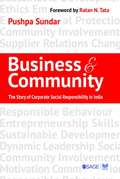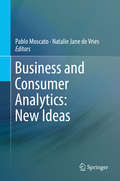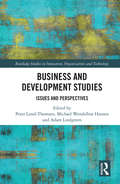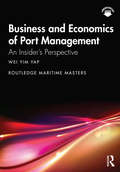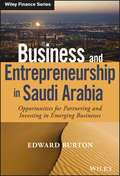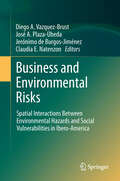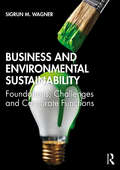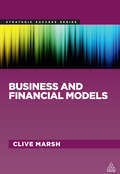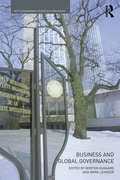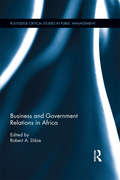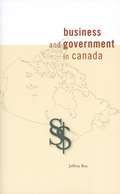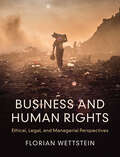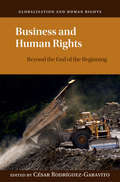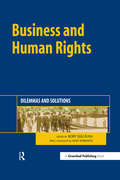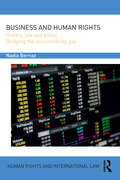- Table View
- List View
Business and Buddhism
by Joan MarquesBusiness and Buddhism explores alternative ways of leading in the aftermath of the Great Recession and the many stories of fraud and greed that emerged. The book explores shifts in business perspectives as more value is placed on soft skills like emotional intelligence and listening, and introduces the reader to the principles in Buddhist philosophy that can be applied in the workplace. Buddhist practices are increasingly understood as spiritual, rather than religious per se. In fact, Buddhism is alternately referred to as a philosophy or psychology. In this book, Marques explores the value of applying the positive psychology of Buddhism to work settings. She outlines the ways in which it offers highly effective solutions to addressing important management and organizational behavior related issues, but also flags up critical areas for caution. For example, Buddhism is non-confrontational, and promotes detachment. How can business leaders negotiate these principles in light of the demands of modern day pressures? The book includes end of chapter questions to promote reflection and critical thinking, and examples of Buddhist leaders in action. It will prove a captivating read for students of organizational behavior, management, leadership, diversity and ethics, as well as business consultants.
Business and Climate Change Governance
by Tanja BorzelHow and why do business organisations contribute to climate change governance? The contributors' findings on South Africa, Kenya and Germany demonstrate that business contributions to the mitigation and adaptation to climate change vary significantly.
Business and Community
by Pushpa SundarBusiness and Community is a historical narrative which also highlights emerging critical issues and the achievements as well as deficits of Indian CSR. Its objectives are threefold: - To enhance public knowledge, understanding and appreciation of what Indian business has contributed to society - To enthuse the business community as a whole, especially the younger generation, by highlighting exemplary individualsmpanies in the history of Indian CSR - To identify the factors which inhibit or encourage CSR so as to enable business and government to take appropriate action Written in a simple, non-jargonistic language, it is easy to understand without being simplistic. Its extensive bibliography will be useful for further research.
Business and Community in Medieval England: The Cambridge Hundred Rolls Source Volume
by Mark Casson Catherine CassonOne of the most important manuscripts surviving from thirteenth-century England, the corpus of documents known as the Hundred Rolls for Cambridge have been incomplete until the recent discovery of an additional roll. This invaluable volume replaces the previous inaccurate transcription by the record commission of 1818 and provides new translations and additional appendices. Shedding new light on important facets of business activity in thirteenth-century Cambridge, this volume makes a significant contribution to our knowledge of the early phases of capitalism. This unique text will be of interest to anyone working in the fields of economic and business history, entrepreneurship, philanthropy and medieval studies. A research monograph based on recently discovered historical documents, Compassionate Capitalism: Business and Community in Medieval England, by Casson et al, is also now available from Bristol University Press.
Business and Consumer Analytics: New Ideas
by Pablo Moscato Natalie Jane de VriesThis two-volume handbook presents a collection of novel methodologies with applications and illustrative examples in the areas of data-driven computational social sciences. Throughout this handbook, the focus is kept specifically on business and consumer-oriented applications with interesting sections ranging from clustering and network analysis, meta-analytics, memetic algorithms, machine learning, recommender systems methodologies, parallel pattern mining and data mining to specific applications in market segmentation, travel, fashion or entertainment analytics. A must-read for anyone in data-analytics, marketing, behavior modelling and computational social science, interested in the latest applications of new computer science methodologies.The chapters are contributed by leading experts in the associated fields.The chapters cover technical aspects at different levels, some of which are introductory and could be used for teaching. Some chapters aim at building a common understanding of the methodologies and recent application areas including the introduction of new theoretical results in the complexity of core problems. Business and marketing professionals may use the book to familiarize themselves with some important foundations of data science. The work is a good starting point to establish an open dialogue of communication between professionals and researchers from different fields.Together, the two volumes present a number of different new directions in Business and Customer Analytics with an emphasis in personalization of services, the development of new mathematical models and new algorithms, heuristics and metaheuristics applied to the challenging problems in the field. Sections of the book have introductory material to more specific and advanced themes in some of the chapters, allowing the volumes to be used as an advanced textbook. Clustering, Proximity Graphs, Pattern Mining, Frequent Itemset Mining, Feature Engineering, Network and Community Detection, Network-based Recommending Systems and Visualization, are some of the topics in the first volume. Techniques on Memetic Algorithms and their applications to Business Analytics and Data Science are surveyed in the second volume; applications in Team Orienteering, Competitive Facility-location, and Visualization of Products and Consumers are also discussed. The second volume also includes an introduction to Meta-Analytics, and to the application areas of Fashion and Travel Analytics. Overall, the two-volume set helps to describe some fundamentals, acts as a bridge between different disciplines, and presents important results in a rapidly moving field combining powerful optimization techniques allied to new mathematical models critical for personalization of services. Academics and professionals working in the area of business anyalytics, data science, operations research and marketing will find this handbook valuable as a reference. Students studying these fields will find this handbook useful and helpful as a secondary textbook.
Business and Development Studies: Issues and Perspectives (Routledge Studies in Innovation, Organizations and Technology)
by Adam Lindgreen Peter Lund-Thomsen Michael Wendelboe HansenBusiness and Development Studies: Issues and Perspectives provides a comprehensive collection of cutting-edge theoretical and empirical contributions to the emerging field of business and development studies. Compared to more traditional business-school accounts of business in developing countries which focus on the challenges and opportunities of doing business in developing countries, this anthology explores whether, how, and under what conditions business contributes to the achievement of economic, social, and environmental goals in developing countries. The book consolidates the current status of academic work on business and development, identifies state of the art in relation to this academic field, and establishes a future research agenda for ‘business and development studies’ as an emerging academic discipline within the social sciences. The book will be of interest to researchers and students, including economists, geographers, sociologists, political scientists, corporate social responsibility specialists, and development scholars who are seeking an in-depth overview of current debates about the role of business as a development agent in the Global South. The book is also of relevance to practitioners that are engaged in work with the private sector seeking to enhance the positive effects and minimize the negative economic, social, and environmental consequences of business activity in the Global South.
Business and Economics of Port Management: An Insider’s Perspective (Routledge Maritime Masters)
by Wei Yim YapBusiness and Economics of Port Management is a comprehensive but concise textbook and reference for insights into the workings of port industry from the business and economics perspectives. The book examines port management from various entities which include the government, port operator, shipping line, logistics companies and other port service providers. It provides in-depth discussions on strategic issues, challenges and disruptions that are faced by this industry. Given the uniqueness of each port and international nature of the port business, the book comes with useful case studies and lessons from different port regions around the world. Key lessons on challenges and issues faced by port managers, developers and regulators are highlighted and discussed using a combination of professional insights and publicly available information sources. The aim is to illustrate the decision-making process with the purpose of contributing to better outcomes for the industry, government and the public at large. Anyone who is approaching the subject matter will gain utmost understanding of how ports are critical in the global economy and societal well-being.
Business and Entrepreneurship in Saudi Arabia: Opportunities for Partnering and Investing in Emerging Businesses (Wiley Finance)
by Edward BurtonAn investor's crucial guide to the changing face of Saudi Arabian business Business and Entrepreneurship in Saudi Arabia is an essential reference guide, informing investors on the key issues that define how business will be done as the nation's family-owned businesses change hands. Supported by the U.S.-Saudi Arabian Business Council, this book introduces the reader to the new Saudi entrepreneur and explains why Saudi Arabia's boom deserves more of the world's attention. As the heads of family-owned businesses age and corporate boards are reshaped, business practices will be influenced by the ascension of the country's young leaders. Interviews with young Saudi entrepreneurs describe the challenges, triumphs, failed attempts, and successful endeavors they experience every day as time-tested traditional models bump up against more modern, innovative ideas and methods. The book's companion website features a variety of useful tools and documents that help readers implement the concepts presented, and the firsthand information provides deep insight into the future of these companies. Saudi Arabia is profoundly influencing the technological advances of multiple industries through increasing collaboration and in-country partnerships with communities around the world. The evolution of the Kingdom's family-owned businesses is becoming more important to investors as young Saudis claim their legacies, and this book provides an insightful understanding of the changing nature of Saudi business. Meet the emerging entrepreneur class of Saudi Arabia Learn how the Saudi boom affects global business Discover what investors need to know about the Saudi economy Examine how time and technology is reshaping the way business is done Gain useful insight into the direction management of the Kingdom's growth will take over the next five years The Saudi economy constitutes thirty percent of the Arab world's GDP, and sixty percent of the population is under the age of thirty. Business and Entrepreneurship in Saudi Arabia provides essential information investors need to navigate the changing tide of doing business in Saudi Arabia.
Business and Environmental Risks: Spatial Interactions Between Environmental Hazards and Social Vulnerabilities in Ibero-America
by Diego A. Vazquez-Brust Claudia E. Natenzon Jerónimo de Burgos-Jiménez José A. Plaza-ÚbedaBased on detailed research funded across two continents and involving universities in Argentina, Spain and the UK, this book sets out an innovative, multidisciplinary approach to assessing both environmental and social risks in a given territorial area. Using data from a number of Ibero-American nations, the study combines environmental, socio-economic and geographic factors to construct a set of spatial and technical indicators that measure the social vulnerability and industrial hazardousness of a defined area. Aggregating these indicators in a geographic information system (GIS) allows researchers to assess the potential risk to which a certain area and its population are subject as a result of the environmental deterioration caused by co-located industrial activity.
Business and Environmental Sustainability: Foundations, Challenges and Corporate Functions
by Sigrun M. WagnerEnvironmental sustainability is increasingly important to organisations, whether for regulatory, financial or ethical reasons. Business and Environmental Sustainability looks at the environmental aspect of sustainability for all organisations pursuing competitive advantage. The book provides theoretical foundations from science, economics, policy and strategy, introduces three environmental challenges (climate change, pollution and waste) and looks at how corporate functions can address these. This textbook provides a thorough foundation by introducing readers to the science, reasoning and theory behind environmental sustainability and then delves into how these ideas translate into principles and business models for organisations to use. Next, it covers environmental challenges from climate change, pollution and waste, and then goes on to examine the different corporate functions (from supply chain management to human resources) to illustrate how environmental sustainability is managed and put into practice in organisations. Finally, a set of integrative case studies draws everything together and enables the reader to apply various analytical tools, with the aim of understanding how companies can not only reduce their environmental footprint but can positively contribute to environmental sustainability. Written by an award-winning lecturer, Business and Environmental Sustainability boasts a wealth of pedagogical features, including examples from a range of industries and countries, plus a companion website with slides, quiz questions and instructor material. This will be a valuable text for students of business, management and environmental sustainability and will also be suitable for broader courses on corporate responsibility and sustainability across environmental studies, political science and engineering.
Business and Financial Models
by Clive MarshA good business model should describe how an organization creates and delivers value. A vital tool for business strategy, it enables a company to experiment with different ideas and scenarios in a safe, low-risk environment, to consider what it is aiming to achieve, and to prioritize accordingly. Financial modelling involves building a financial evaluation from a more abstract business model, enabling hypotheses and scenarios to be translated into numbers. Business and Financial Models provides an accessible introduction to these essential strategic practices, with guidance on using Microsoft Excel for projection and analysis. The book takes you through the process of building your model from the initial phase of formulating questions through modelling cash flow, budgets, investment appraisal and 'dashboard' tools for monitoring performance. Business and Financial Models also includes coverage of new visual thinking techniques, and how these can be incorporated into conventional business modelling.
Business and Global Governance (Routledge Studies in Globalisation)
by Anna Leander Morten OugaardOver the past two decades, the role of business in global governance has become increasingly topical. Transnational business associations are progressively more visible in international policy debates and in intergovernmental institutions, and there is a heightened attention given to global policy-making in national and international business communities. This text examines and explains the multiple modes of engagement between business and global governance; it presents a variety of theoretical approaches which can be used to analyse them, along with empirical illustrations. Featuring a range of leading US and European scholars, it is divided into three parts that summarize different modes of engagement. Each section is illustrated by two or three studies that represent a distinct theoretical take on the issue with empirical illustrations. The book examines: Business as master and purpose of global governance Business as subject and opponent to global governance Business as partner and facilitator of global governance This book will be of interest to students and scholars of Business Studies, International Relations, International Politics and International Political Economy, as well as for practitioners – in the public and private sector.
Business and Governance in South Africa: Racing to the Top? (Governance and Limited Statehood)
by Christian R. Thauer Tanja A. BörzelThe authors identify conditions under which firms seek higher rather than lower regulation in a context of weak regulatory capacities by engaging in self-regulation or partnering up with the government and/or NGOs. They analyse how firms in the automotive, food, textile, and mining sectors fight environmental pollution and HIV/AIDS.
Business and Government Relations in Africa (Routledge Critical Studies in Public Management)
by Robert A. DibieThis book endeavors to take the conceptualization of the relationship between business, government and development in African countries to a new level. In the twenty-first century, the interests and operations of government and business inevitably intersect all over the African continent. No government, federal or state, can afford to ignore the needs of business. But what are these needs, how does business express its needs to government and what institutions organize government-business relations in African countries? How should government regulate business, or should it choose to let the markets rule? Government and Business Relations in Africa brings together many of sub-Saharan African leading scholars to address these critical questions. Business and Government Relations in Africa examines the key players in the game—federal and state governments and business groups—and the processes that govern the relationships between them. It looks at the regulatory regimes that have an impact on business and provides a number of case studies of the relationships between government and economic development around the African continent, highlighting different processes and practices. It shows the latest state of knowledge on the topic and will be of interest both to students at an advanced level, academics and reflective practitioners. It addresses the topics with regard to business-government relations and will be of interest to researchers, academics, policymakers, and students in the fields of African politics, comparative politics, public policy, business and politics, sustainable development and sustainability, economic development, and managerial economics.
Business and Government in Canada (Governance Series)
by Jeffrey RoyBoundaries between business and government are increasingly fluid and often transcended. Yet it remains important to acknowledge and make appropriate use of the fundamental differences between these sectors. Five areas that offer the most critical challenges to business and government in Canada today are corporate governance, lobbying and influence, security and privacy, public-private partnerships, and geography and development. This book is an exploration of the systemic dynamics of the inter-sectoral governance that shape the collective performance of Canada's national jurisdiction. Three perspectives of the relational dynamics between business and government, drawn from leading Canadian scholars, are adopted in order to frame the examination of independence, influence, and interdependence. This book makes a case for the advancement of “virtuous hybrids,” while pointing out the challenges that remain in terms of the formation and successful performance of such hybrids in Canada, a challenge that calls for political leadership as well as social learning. An informed and engaged public, wearing multiple hats (i.e. as voter, shareholder, employee, activist etc.) would be the ultimate arbiter of sectoral and collective performance.
Business and Government: Campaign Contributions and Lobbying in the United States
by Karthik Ramanna Sandra J. Sucher Ian Mckown CornellThis note on business-government relations introduces students to the state of campaign contributions and lobbying by corporations in the United States. The note develops two hypotheses as to the impact of corporate political engagement: (i) a vehicle to facilitate good government; and (ii) an instrument of special-interest capture. The note can be used to generate a discussion on the following issues: (1) In a democratic capitalist society, what is the appropriate role of business in government? (2) When it comes to political contributions, should corporations have the same rights and responsibilities as individuals? The note also describes the various practical choices businesses face on political engagement, including disclosure options and options to engage through trade or ideological associations. This description can be used to encourage business students to develop an aspiration for their companies' political engagement strategies
Business and Human Rights
by Lynn Sharp Paine Lara AdamsonsThis note addresses some of the most frequently asked questions about the relation between human rights and business. Topics include the definition of human rights, the business leader's role regarding human rights, and legal liability of companies and executives for violating human rights.
Business and Human Rights Business and Human Rights: Ethical, Legal, and Managerial Perspectives
by Florian WettsteinThe first of its kind, this comprehensive interdisciplinary textbook in Business and Human Rights (BHR) connects and integrates themes, discussions, and issues in BHR from both legal and non-legal perspectives, and provides a solid foundation for cross-disciplinary conversations. It equips students, teachers, and scholars with the necessary knowledge to navigate and advance evolving BHR debates, and fosters a thorough understanding of the academic foundations, evolving policy spaces, and practical approaches in BHR. Short cases throughout translate conceptual insights into practical solutions. Study, reflection, and discussion questions help readers to consolidate and synthesize their understanding of the material and provide stimulating frameworks for debate in the classroom and beyond. The book features a collection of online resources to support students and instructors in their preparation for courses and assignments.
Business and Human Rights in Europe: International Law Challenges (Transnational Law and Governance)
by Angelica BonfantiTransnational business activities are important drivers of growth for developing and the least developed countries. However, they can also negatively impact the enjoyment of human rights. In some cases, multinational enterprises (MNEs) have even been accused of grave human rights abuses in the territory of the states where their subsidiaries operate. Since the parent companies of many MNEs are incorporated under the law of European states, those countries’ domestic law and the European legal framework play a crucial role in establishing how their activities should be conducted – also throughout their supply chains – and which remedies will be available when corporate human rights violations occur. In recent years, the European Union, the Council of Europe and their Member States have been adopting policies and legislation to ensure respect for human rights by businesses and have developed a body of related case law. These legal instruments can be considered the European responses to the challenges posed at international-law level, and they constitute the focus of research of this book. Through its collected chapters – written by scholars and practitioners under the direction of the editor, Angelica Bonfanti – the book identifies the European solutions to the business and human rights international legal issues, provides an overall assessment of their effectiveness, and examines their potential evolution.
Business and Human Rights in Southeast Asia: Risk and the Regulatory Turn (Routledge Research in Human Rights Law)
by Mahdev Mohan Cynthia MorelBusiness and human rights has emerged as a distinct field within the corporate governance movement. The endorsement by the United Nations Human Rights Council of a new set of Guiding Principles for Business and Human Rights in 2011 reinforces the State’s duty to protect against human rights abuses by third parties, including business; the corporate responsibility to respect human rights; and greater access by victims to effective remedy, both judicial and non-judicial. This book draws on the UN Guiding Principles and recent national plans of action, to provide an overview of relevant developments within the ASEAN region. Bridging theory and practice, the editors have positioned this book at the intersection of human rights risk and its regulation. Chapter authors discuss the implications of key case-studies undertaken across the region and various sectors, with a particular focus on extractive industries, the environment, and infrastructure projects. Topics covered include: due diligence and the role of audits; businesses’ responsibilities to women and children; and the mitigation of human rights risks in the region's emerging markets. The book sheds light on how stakeholders currently approach business and human rights, and explores how the role of ASEAN States, and that of the institution itself, may be strengthened. In doing so, the book identifies critical challenges and opportunities that lie ahead for the region in relation to business and human rights. This book will be of excellent use and interest to scholars, practitioners and students of human rights, business and company law, international law, and corporate governance.
Business and Human Rights: Beyond the End of the Beginning (Globalization and Human Rights)
by César Rodríguez-GaravitoThe regulation of business in the global economy poses one of the main challenges for governance, as illustrated by the dynamic scholarly and policy debates about the UN Guiding Principles on Business and Human Rights and a possible international treaty on the matter. This book takes on the conceptual and legal underpinnings of global governance approaches to business and human rights, with an emphasis on the Guiding Principles (GPs) and attention to the current treaty process. Analyses of the GPs have tended to focus on their static dimension, such as the standards they include, rather than on their capacity to change, to push the development of new norms, and practices that might go beyond the initial content of the GPs and improve corporate compliance with human rights. This book engages both the static and dynamic dimensions of the GPs, and considers the issue through the eyes of scholars and practitioners from different parts of the world. Offers the first systematic effort by prominent business and human rights scholars and practitioners to take stock of the GPs and the broader theoretical, legal, and policy debates and initiatives they have sparked. Contributes to a dynamic and timely debate that has gained widespread attention in academic and policy circles regarding the protection of human rights in business proceedings. Features chapters by scholars and practitioners from across the globe.
Business and Human Rights: Dilemmas and Solutions
by Mary Robinson Rory SullivanThe end of the Cold War and the virtual disappearance of communism have completely altered the world economy. The supply chains of supermarkets and consumer goods industries have spread ever more widely and deeply into Asia, Africa and South America, while oil, mining and financial companies, among many others, have invested heavily in countries that were previously denied to them by political or ideological barriers.While companies have seized the opportunities presented by globalisation, they have in many cases been completely unprepared for the risks presented by their headlong rush into these new markets. Companies have found themselves and their business partners operating in countries where corruption, injustice, internal conflict and human rights violations are rife. An increasingly alert and critical world has acted as watchdog, highlighting corporate malpractice and the links between corporations and repressive regimes.It has increasingly been argued that companies have responsibilities for the protection and promotion of human rights. These arguments are, at least to some extent, accepted by companies. Yet, despite the increasing use of human rights language in public policy discourses, the expectations of companies remain unclear. That is, what are the ethical imperatives? What are the legal expectations? How far does responsibility extend? What can companies actually do in practice? The debate is further complicated by the range of actors (companies, governments, international institutions, local communities, non-governmental organisations [NGOs], trade unions, consumers) involved; by debates around free trade versus and fair trade; by the discussion of the specific role of governments; and by questions about the relative merits of regulation and self-regulation.Business and Human Rights provides an analysis of the relationship between companies and human rights in the context of globalisation. The analysis is in two parts. The first maps the reasons (financial, ethical, regulatory) why human rights have become a business issue. However, simply because there are reasons why companies should be concerned about human rights, this does not say what companies should or could do. Therefore, the second part of the book looks at the practical experiences of companies in responding to specific human rights issues in the context of their own operations, in their supply chains and in specific countries. These case studies, many of which have not been previously published or analysed from the perspective of human rights, provide important insights into questions such as: How do companies organise themselves to respond to human rights challenges? What have the experiences been-positive and negative? How have companies responded to specific situations? What are the roles and responsibilities of other actors: government, trade unions, NGOs? What are the limits to responsibility?In this outstanding collection, Rory Sullivan has drawn together leading thinkers and actors from the debate on business and human rights, to establish how far the business and human rights debate has evolved, and explore the many complex questions around roles, responsibilities and solutions that remain to be answered.
Business and Human Rights: History, Law and Policy - Bridging the Accountability Gap (Human Rights and International Law)
by Nadia BernazBusiness corporations can and do violate human rights all over the world, and they are often not held to account. Emblematic cases and situations such as the state of the Niger Delta and the collapse of the Rana Plaza factory are examples of corporate human rights abuses which are not adequately prevented and remedied. Business and human rights as a field seeks to enhance the accountability of business – companies and businesspeople – in the human rights area, or, to phrase it differently, to bridge the accountability gap. Bridging the accountability gap is to be understood as both setting standards and holding corporations and businesspeople to account if violations occur. Adopting a legal perspective, this book presents the ways in which this dual undertaking has been and could be further carried out in the future, and evaluates the extent to which the various initiatives in the field bridge the corporate accountability gap. It looks at the historical background of the field of business and human rights, and examines salient periods, events and cases. The book then goes on to explore the relevance of international human rights law and international criminal law for global business. International soft law and policy initiatives which have blossomed in recent years are evaluated along with private modes of regulation. The book also examines how domestic law, especially the domestic law of multinational companies’ home countries, can be used to prevent and redress corporate related human rights violations.
Business and Legal Forms for Illustrators (Business And Legal Forms Ser.)
by Tad CrawfordThe fourth edition of this popular guide contains twenty-nine of the most essential business and legal forms to meet the everyday needs of today’s illustrators. Updated throughout, new forms include a promissory note, releases, and an agreement to arbitrate. Each form is accompanied by step-by-step instructions, advice on standard contractual provisions, and unique negotiation checklists for making the best deal. Included are:Estimate Confirmation of Assignment Invoice Illustrator-Agent Contract Book Publishing Contract Collaboration Contract Contract for the Sale of an Artwork Contract for Receipt and Holding of Artwork Illustrator-Gallery Contract with Record of Consignment and Statement of Account Licensing Contract to Merchandise Images Release Form for Models Property Release Permission Form Nondisclosure Agreement for Submitting Ideas Copyright Transfer Form Application for Copyright Registration of Artwork License of Rights and Electronic Rights Contract with an Independent Contractor Trademark Application Commercial Lease Sublease Lease AssignmentThe collection provides a password and link to a supplemental website, which contains all the discussed forms for both the PC and Mac platforms. Thorough discussions of legal issues relevant to the industry make this a must-read for any illustrator-established or starting out.Allworth Press, an imprint of Skyhorse Publishing, publishes a broad range of books on the visual and performing arts, with emphasis on the business of art. Our titles cover subjects such as graphic design, theater, branding, fine art, photography, interior design, writing, acting, film, how to start careers, business and legal forms, business practices, and more. While we don't aspire to publish a New York Times bestseller or a national bestseller, we are deeply committed to quality books that help creative professionals succeed and thrive. We often publish in areas overlooked by other publishers and welcome the author whose expertise can help our audience of readers.
Business and Legal Forms for Industrial Designers
by Tad Crawford Carl W. Battle Eva Doman BruckForty-five essential forms and checklists-all ready to copy and put to immediate use in any industrial design studio-are provided here. Each form includes step-by-step instructions and can be used as is, or easily tailored to meet a specific business situation. Some of the forms include jobs master index, project plan and budget, time sheet, creative log, initial survey, estimate request form, work change order, collection letters, and much more. Allworth Press, an imprint of Skyhorse Publishing, publishes a broad range of books on the visual and performing arts, with emphasis on the business of art. Our titles cover subjects such as graphic design, theater, branding, fine art, photography, interior design, writing, acting, film, how to start careers, business and legal forms, business practices, and more. While we don't aspire to publish a New York Times bestseller or a national bestseller, we are deeply committed to quality books that help creative professionals succeed and thrive. We often publish in areas overlooked by other publishers and welcome the author whose expertise can help our audience of readers.


